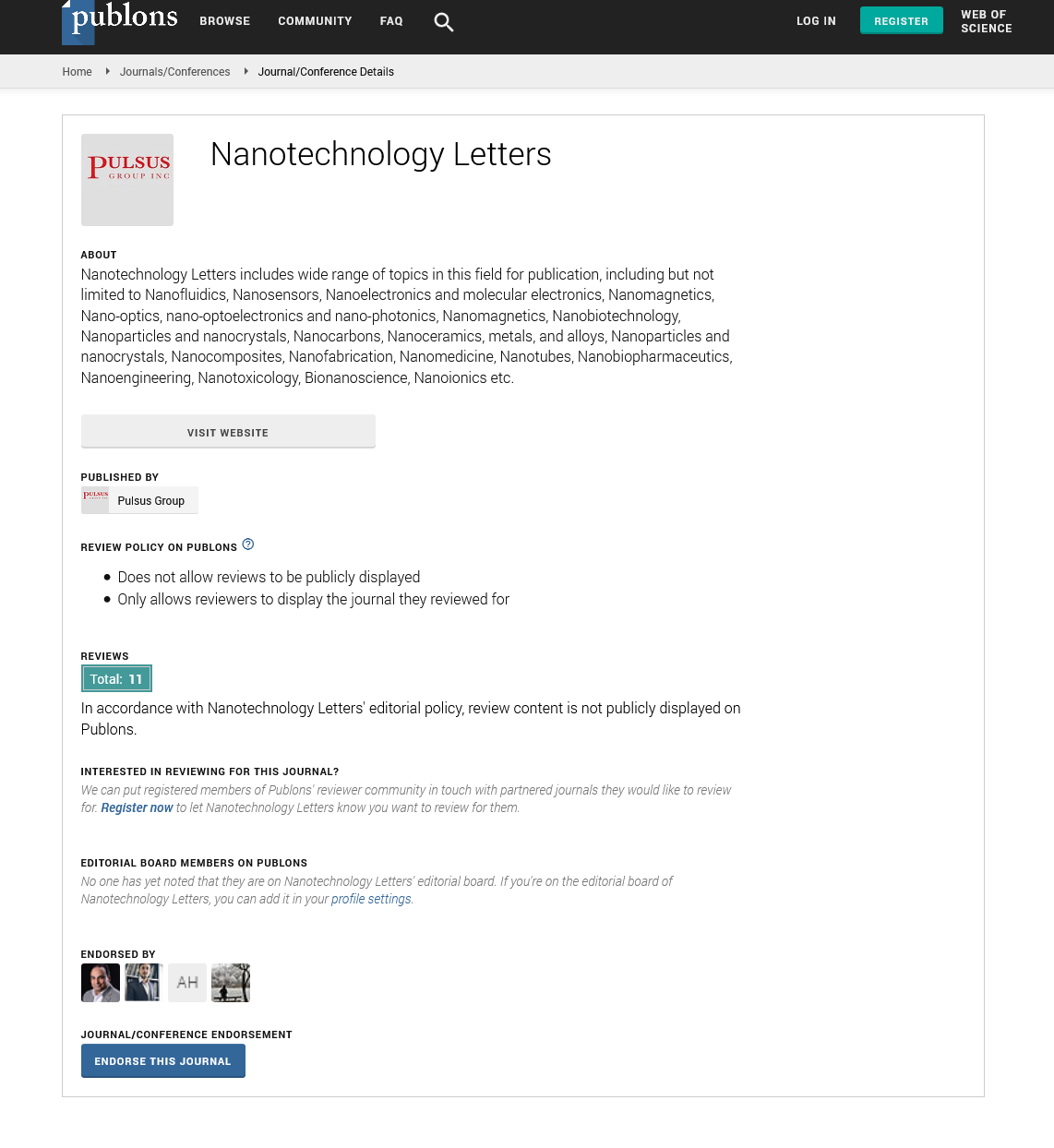Advancements in the utilization of nanomaterials for the diagnosis of lung cancer
Received: 09-Mar-2023, Manuscript No. pulnl-23-6786; Editor assigned: 12-Mar-2023, Pre QC No. pulnl-23-6786 (PQ); Accepted Date: Mar 26, 2023; Reviewed: 15-Mar-2023 QC No. pulnl-23-6786 (Q); Revised: 22-Mar-2023, Manuscript No. pulnl-23-6786 (R); Published: 27-Mar-2023, DOI: 10.37532. pulnl.23.8 (2) 36-37
Citation: Shukla. T. Advancements in the utilization of nanomaterials for the diagnosis of lung cancer. Nanotechnol. lett.; 8(2):36-37
This open-access article is distributed under the terms of the Creative Commons Attribution Non-Commercial License (CC BY-NC) (http://creativecommons.org/licenses/by-nc/4.0/), which permits reuse, distribution and reproduction of the article, provided that the original work is properly cited and the reuse is restricted to noncommercial purposes. For commercial reuse, contact reprints@pulsus.com
Abstract
Lung cancer represents a formidable malignancy characterized by significant morbidity and mortality, primarily attributable to challenges in early diagnosis and the rapid onset of metastasis. The emergence of nanotechnology introduces innovative concepts and research approaches aimed at improving the diagnosis of lung cancer through the utilization of nanomaterials as diagnostic agents, thereby augmenting diagnostic accuracy.
Key Words
Nanomaterials; Lung cancer diagnosis; Biomarker detection
Introduction
Environmental pollution and unhealthy lifestyle choices have led to an increasing incidence of lung cancer. This disease is characterized by rapid growth, early metastasis, low sensitivity, and limited specificity in its early detection, making it the deadliest among all cancer types .Various diagnostic methods have been developed for lung cancer, including sputum cytology, pleural fluid cytology, Auto Fluorescence Bronchoscopy (AFB), Endoscopic Ultrasound (EUS), Endo Bronchial Ultrasound (EBUS), and imaging techniques such as Chest Radiographs (CXR), Computed Tomography (CT) scans (including low-dose helical CT scans), bone scans, Positron Emission Tomography (PET), and Magnetic Resonance Imaging (MRI) .
However, the detection of cancer biomarkers (such as specific proteins, nucleic acids, cells, and volatile organic compounds) in bodily fluids like blood, urine, sputum, exhaled breath, and tissues faces limitations due to their low detection sensitivity, lack of specificity, complex procedures, and the poor adsorption of gaseous molecules on solid substrates. Imaging examinations can impose a substantial financial burden on patients and carry the risk of cumulative radiation exposure. Moreover, the limited tissue penetration of radiation and the low specificity of photographic developers can result in false-negative outcomes . In clinical practice, X-ray chest imaging serves as a fundamental method for detecting lung cancer but falls short of providing detailed internal information. Consequently, Low-Dose Computed Tomography (LDCT) has emerged as a promising screening tool for lung cancer, offering reduced radiation exposure and improved safety .
Despite these advancements, the existing diagnostic methods still suffer from inadequate sensitivity, with sputum cytology at 66%, pleural fluid cytology at 70%, PET scans at 88%, CT scans at 55% and bone scans at 77%. Therefore, it remains imperative to develop cost-effective, sensitive, convenient, and non-invasive approaches for diagnosing lung cancer.
APPLICATIONS OF NANOPARTICLES IN DIAGNOSIS OF CANCER
Cancer typically involves a series of molecular or cellular changes that occur during its development and progression. These changes can serve as specific targets for accurate diagnosis. Common diagnostic approaches involve the use of imaging examinations and biomarker detection, both of which are associated with identifying specific targets within cancerous lesions.
IN VIVO EXAMINATION
In vivo methods primarily encompass techniques such as AFB, EUS, CT, PET, and MRI, all of which offer visual representations to convey disease-related information. Among these, MRI stands out for its ultrahigh resolution, allowing for clear visualization of tumor anatomy and boundaries. However, it is constrained by longer imaging times and a lack of molecular imaging data. PET imaging, on the other hand, exhibits high sensitivity and provides systemic information about lesions but faces limitations in spatial resolution and the potential for false positives due to inadequate specificity. Low-dose CT scans offer insights into the size, shape, and positioning of cancer cells within lymph nodes. However, they suffer from low sensitivity and specificity due to artifacts caused by internal organ motion and tattoos in the images.
1. Single-modal imageological examination-mri
MRI is an imaging technique known for its high resolution and ability to provide extensive visual information about anatomical structures and subtle details. However, when it comes to lung imaging, MRI faces challenges such as motion artifacts, numerous susceptibility gradients, and low proton density, making its direct application for lung detection impractical.
2. Single-modal imageological examination-pet
PET is an advanced diagnostic imaging technology known for its high sensitivity, excellent temporal resolution, capacity for systemic image quantitative analysis, and the ability to penetrate tissues without limitation. The radioisotopes employed in PET imaging have relatively short half-lives, such as 11C with a half-life of 20 minutes, 13N with a half-life of 10 minutes, and 15O with a half-life of 2 minutes. In contrast, 64Cu has garnered significant attention due to its longer half-life, extending up to 12.7 hours.Researchers have discovered that polyglucose nanoparticles, composed of cross-linked dextrans and their derivatives (known as dextran nanoparticles), exhibit remarkable affinity for Tumor-Associated Macrophages (TAMs) .To facilitate clinical oncologic diagnosis via PET imaging, 64Cu-labeled dextran nanoparticles are employed in combination with macrocyclic chelators. However, the inherent instability of radiometal-chelator complexes within the body can significantly impact the physicochemical properties of nanoparticles during PET imaging.
3. Multi-modal imageological examination
In contrast to the use of a single contrast agent for imaging, employing multiple contrast agents in multimodal imaging can offer supplementary information that enhances cancer diagnosis. The significant challenge lies in effectively delivering multiple contrast agents without causing interference in the imaging signals. To address this challenge, a hybrid contrast agent known as USRPs-Cy5.5 was developed. This agent was created by covalently attaching cyanine 5.5 to nebulized gadolinium nanoparticles, enabling fluorescence tomography and Ultrashort Echo-Time Magnetic Resonance Imaging (UTEMRI) for non-invasive detection of lung cancer.
IN VITRO DETECTION
Biomarker testing has been proven as an effective approach for the analysis and diagnosis of cancer. This includes various types of biomolecules such as proteins (e.g., Carcino Embryonic Antigen (CEA), Cytokeratin 19 Fragment Antigen 21-1 (CYFRA21-1), Neuron-Specific Enolase (NSE), dickkopf-1 etc.), nucleic acids (DNA, RNA), cells (Tumor-Associated Macrophages or TAMs), and volatile organic compounds (aldehydes) .Biomarker detection enables noninvasive serial sampling, but the limited specificity of these biomarkers is attributed to the considerable inter-tumor heterogeneity.
1. Gold nanoparticles
Gold nanoparticles have gained significant prominence in cancer biomarker detection due to their utilization of the Surface Plasmon Resonance (SPR) effect, precise control over particle size and volume, and excellent biocompatibility. The SPR effect serves as the foundation for generating and amplifying detection signals. Specifically, the mucin 1 (MUC1) specific aptamer is covalently attached to gold nanoparticles through the selfassembly of 4-([2,20:50,200-terthiophen]-30-yl) benzoic acid (TTBA). This highly sensitive cytosensing approach significantly enhances the selective detection signal for lung cancer, achieving a remarkable detection limit of 8 cells/ml To regulate the detection process, an enzyme is introduced to initiate detection.
1. Carbon nanomaterials
Carbon nanomaterials are promising candidates for the fabrication of electrochemical biosensors owing to their expansive surface area, robust chemical and thermal stability, outstanding electrical and thermal conductivity, exceptional electron transport rate, adjustable bandgap, and impressive mechanical strength. To enhance electrical conductivity and the effective electrochemical surface area, materials like graphene oxide and ordered mesoporous carbon can be applied to coat the surface of nano-carriers through a two-step electropolymerization process .
2. Quantum Dots
Quantum Dots (QDs) have commonly been utilized to develop Electro Chemical Luminescence (ECL) sensors due to their remarkable attributes, including high fluorescence intensity, distinct size-dependent electrochemical properties, extended fluorescence lifetime, robust photostability, and the adjustability of ECL parameters. An economical and high-throughput detection system can be established using a suspension and planar microarray format to detect multiple markers (e.g., CEA, CYFRA21-1, NSE).In this approach, a suspension state is applied to immobilize the target proteins, forming a sandwich structure between magnetic beads and QDs through specific antibody-antigen interactions. By modifying lung cancer-specific antibodies onto the surface of QDs, the detection of the target can be theoretically achieved.
Conclusions
The challenges associated with the utilization of nanomaterials for lung cancer diagnosis have been extensively discussed. While various nanoparticles have demonstrated their potential in detecting lung cancer and have made significant strides in improving detection limits, sensitivity, simplifying diagnostic procedures, and reducing the time required for diagnosis, there are still hurdles to overcome in terms of specificity, biosafety, detection efficiency, diagnostic cost, and patient comfort.
Nanomaterials are expected to address these challenges by enhancing the selective internalization of diagnostic agents into lung cancer cells while minimizing uptake by normal cells.






